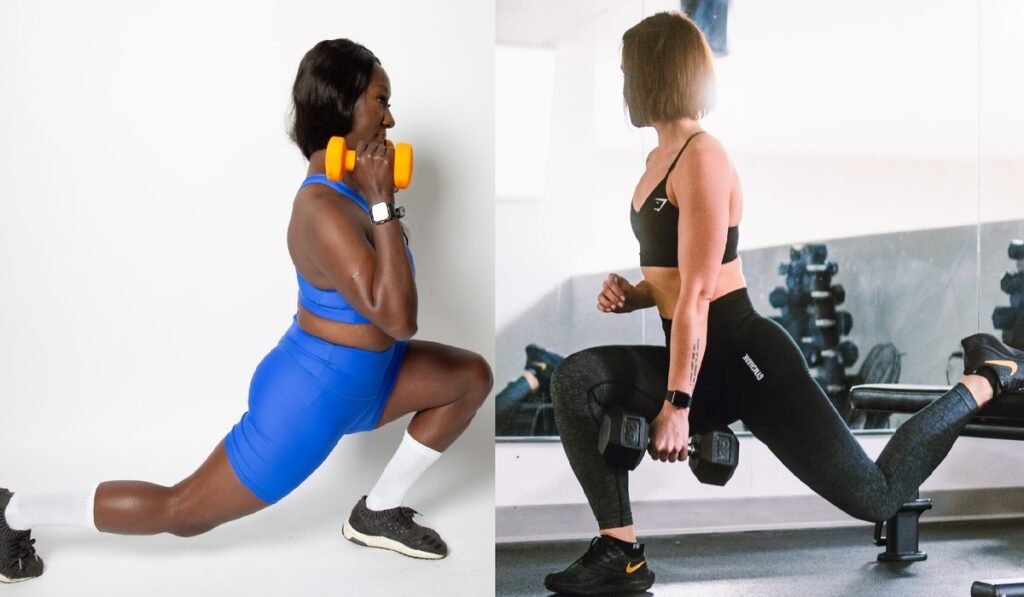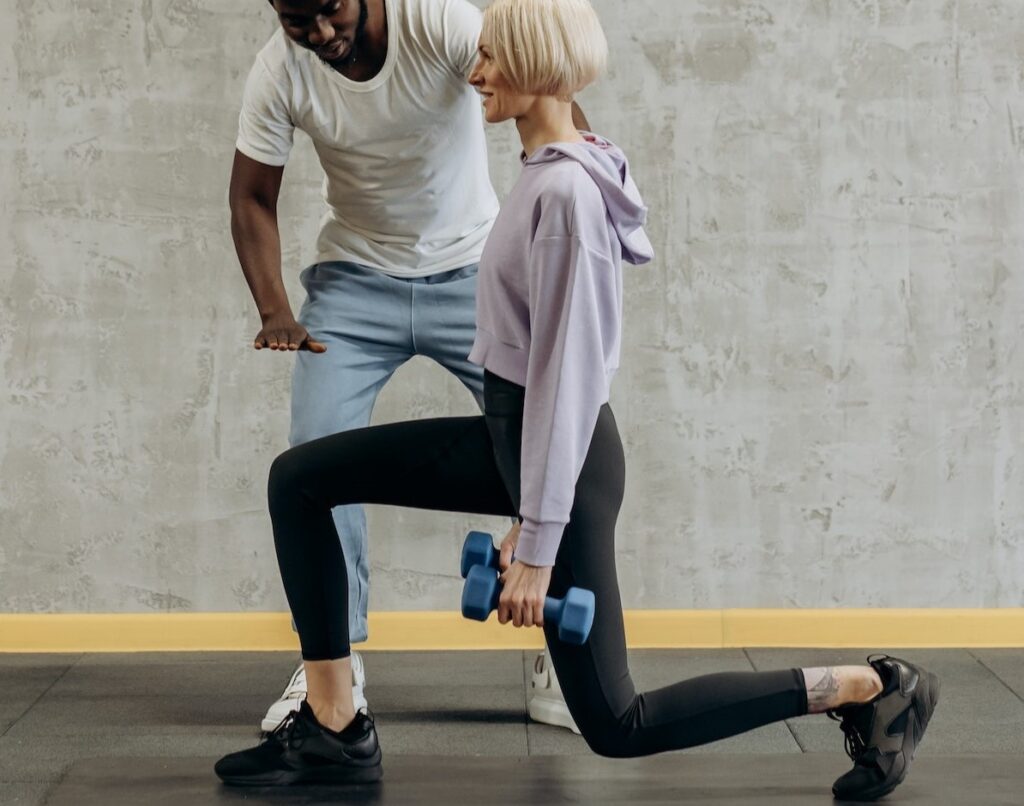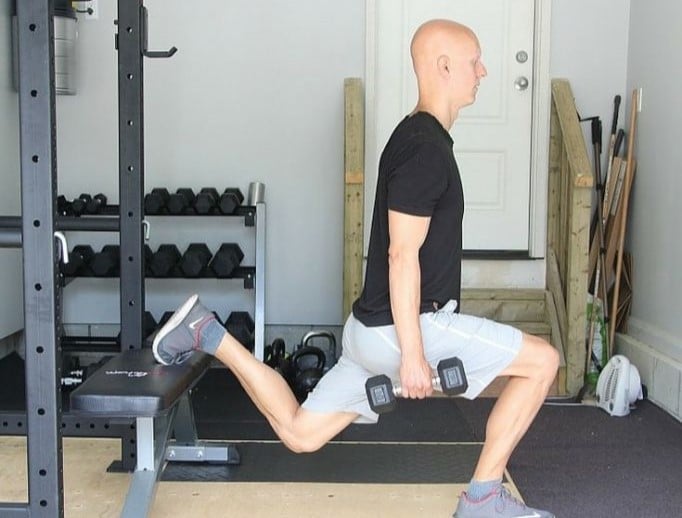Split squats and Bulgarian split squats are both known for their ability to strengthen and improve stability in the lower body. But what are the actual differences between these two exercises?
In this article
- What are the benefits of split squats and Bulgarian split squats?
- What is the difference between split squats vs. Bulgarian split squats?
- What are the muscles targeted by split squats and Bulgarian split squats?
- What equipment do you need for split squats and Bulgarian split squats?
- Which is more difficult to perform?
- How to Correctly Perform Split Squats
- How to Perform Bulgarian Split Squats
- Frequently asked questions (FAQ)
Let’s delve into the anatomy of both exercises, examine the muscles targeted, and the techniques to do them correctly.

What are the benefits of split squats and Bulgarian split squats?
Split squats and Bulgarian split squats are both highly effective lower-body exercises that offer numerous benefits. For starters, they help to build strength and muscle in your quadriceps, hamstrings, and glutes, effectively sculpting your lower body.
Because these exercises are performed on one leg at a time, they also improve balance and coordination, while encouraging better body symmetry by reducing muscular imbalances.
These exercises are great for enhancing hip mobility too, as the forward and downward movement requires a good range of motion in your hip joint. Additionally, they can help improve your core strength since maintaining balance during these exercises requires a strong and engaged core.
The Bulgarian split squat, in particular, can provide an additional benefit: it allows for a greater range of motion compared to the regular split squat, which can lead to increased muscular activation and potentially greater gains in strength and muscle mass.
What is the difference between split squats vs. Bulgarian split squats?
The primary difference between split squats and Bulgarian split squats comes down to foot placement.
In split squats, both feet remain on the ground, one forward and one behind, while in Bulgarian split squats, the rear foot is elevated on a bench or similar platform. This variation alters the balance challenge and muscle engagement between the two exercises.
Split squats:

Bulgarian split squats:

What are the muscles targeted by split squats and Bulgarian split squats?
Both split squats and Bulgarian split squats primarily target the quadriceps, hamstrings, and gluteus muscles. However, due to the elevated rear foot in Bulgarian split squats, there’s additional activation of the quadriceps and greater recruitment of the gluteus maximus.
As mentioned, these exercises also engage the core and stabilizer muscles for balance and posture during the movement.
What equipment do you need for split squats and Bulgarian split squats?
One of the advantages of the split squat is its simplicity – you don’t require any special gear as both of your feet remain grounded. Conversely, the Bulgarian split squat does call for a bit of equipment, but nothing too complex. If you’re exercising at home, a couch provides an ideal height for the rear leg.
If you’re at a fitness center, a bench would be the most suitable choice for this exercise. It’s best to stay away from using rigid boxes as they can be uncomfortable and press into your foot and ankle.
Which is more difficult to perform?
The Bulgarian split squat presents more of a challenge compared to the regular split squat as it puts a greater strain on the front leg due to reduced support from the rear leg. Additionally, it tests one’s balance more intensively, thereby increasing the need for stability.
When it comes to a progressive exercise routine, beginners often start with the split squat as their initial one-legged exercise owing to these elements. It can be further modified for beginners by using a sturdy surface for support.
As the comfort level with the split squat increases, beginners then move on to different lunge types and eventually to the Bulgarian split squat.
How to Correctly Perform Split Squats
To perform split squats follow these steps:
- Stand upright, feet hip-width apart. Step forward with one foot, ensuring your stance is wide enough for movement.
- Lower your body straight down towards the ground, bending both knees simultaneously. Try to achieve a 90-degree angle with both knees at the lowest point. Keep your torso upright and ensure the back knee is close to but not touching the ground.
- Push through the heel of your front foot to rise back up, straightening both legs.
- Perform the desired number of reps, then switch legs and do the same.
How to Perform Bulgarian Split Squats
To perform Bulgarian split squats follow these steps:
- Stand a couple of feet away from a bench or step, with your back to the bench. Extend one foot back and place it on the bench with your toes facing down.
- Lower your body straight down, bending both knees simultaneously. The back knee should move towards the ground but not touch it, and your front knee should be aligned with your foot, not going past your toes.
- Push up through your front heel to rise back up, straightening both legs.
- Do the desired number of reps, then switch legs and repeat.
Remember, form is crucial. It’s better to perform these exercises with lighter weights or even body weight until you can confidently maintain proper form.
Check out this video called “Differences between Split Squats, Lunges, Bulgarian Split Squats” from the Youtube channel.
Frequently asked questions (FAQ)
Got more questions about split squats vs. Bulgarian split squats. Check out some commonly asked questions about this topic below.
What makes Split Squats different from Bulgarian Split Squats?
While both exercises target similar muscle groups and contribute to lower body strength and stability, the key difference lies in their execution. In a split squat, both feet remain on the ground, while in a Bulgarian split squat, the rear foot is elevated on a bench or a similar platform. This elevation in Bulgarian split squats engages the muscles differently and often makes the exercise more challenging due to the added requirement of balance.
Is one exercise superior to the other?
Neither exercise is categorically superior. Both Split Squats and Bulgarian Split Squats have their unique benefits. Split squats are great for beginners as they require less balance and are somewhat easier to perform. Bulgarian split squats, on the other hand, can offer a more intensive workout due to the added balance element, which might be preferred by intermediate or advanced athletes. It really comes down to personal fitness goals, experience level, and preference.
Are there risks of injury associated with these exercises?
As with any exercise, the incorrect technique can lead to injury. It’s crucial to ensure proper form when performing both split squats and Bulgarian split squats to avoid unnecessary strain on your joints, particularly the knees. Modifying the exercise to suit your fitness level, warming up properly before starting, and progressing gradually are key to safe practice. If unsure, it’s always advisable to seek guidance from a fitness professional.
Final Word
Both Split Squats vs. Bulgarian Split Squats hold the power to strengthen and sculpt your lower body, but their execution and difficulty levels differ. Did you learn something new about these exercises and their benefits?
If you liked this article, share it with a friend who might also be interested in learning about squats! Check out our blog for more tips and information about fitness. Here’s to reaching your fitness goals with confidence!
